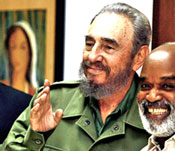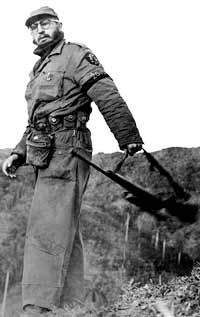Fidel Castro: A friend of revolution
By Ashahed M. MuhammadAssistant Editor
Originally posted: Jun 16, 2006 | Last updated: Feb 20, 2008 - 12:10:00 AM
What's your opinion on this article?
The real reason the U.S. government hates Fidel

Hatian President Rene Preval smiles as he is welcomed by Cuban President Fidel Castro at the Revolution Palace in Havana, Cuba, April 13. Photo: AP/World Wide Photos
|
He is hated by the government of the United States of America and this is simply accepted as fact, however, many lack a fundamental understanding of the history of Fidel Castro and the Cuban Revolution. As a law student at the University of Havana, he was a key leader of the student-led radical nationalism that swept Cuba during the mid-40s. Fighting against corruption and injustice, he had been detained, questioned on numerous occasions and ultimately was imprisoned for his revolutionary activity.
At that time under the leadership of General Fulgencio Batista, Cuba was a place where gambling, corruption and prostitution were the order of the day and many powerful Mafia chieftains had considerable financial investments there. So, many wanted to move the country away from being a playground for the rich and the Mafia.
In 1952, Castro prepared to run for political office as a part of an anti-corruption coalition of political forces. Support for the rebel political movement was strong, but Batista—who had actually been out of political office for several years and living in Florida—returned and staged a bloodless coup using his influence. The Batista-led regime insured that corruption and vice remained unabated as the masses of the people continued to suffer under oppression and mired in a collective quagmire of poverty. The Batista regime shut down universities and outlawed any dissident political parties thinking this crackdown would squash the idealism of those who had been energized by the hope that their people could benefit from revolutionary action.
Castro continued to organize an opposition guerilla army. During a two-year battle, Batista ordered the killings of many thought to be rebel sympathizers in a brutal attempt to squash the revolution. Many were tortured and imprisoned and it is estimated that over 20,000 were killed.

Cuban rebel leader Fidel Castro carries a rifle in the Sierra Maestra Mountains in Cubas Oriente Province in March 1958. During that time, Castro, at the age of 31, and his men had been waging guerrilla warfare against the forces of President Batista. Photo: AP/World Wide Photos
|
During Fidel Castro’s first goodwill tour and visit to the United States, specifically New York in 1960 as leader of Cuba, Castro stayed at the legendary Theresa Hotel in Harlem and used it as his temporary base of operations from which he conducted meetings with national and international leaders such as Gamal Abdel Nasser of Egypt, Malcolm X and Nikita Khrushchev of what was then called the Soviet Union.
Fidel Castro returned to Cuba continuing his plan to lead his people to independence by setting up businesses that would be owned and operated by the Cuban people. He kicked out the American corporations and initiated a program of educational reform insuring that all Cuban people, young and old, urban or rural would be able to read.
In March 1960, President Dwight Eisenhower enlisted members of the exiled Cuban community living in the United States, initiating a secret training program for those who would be willing pawns and tools of the United States government to attempt to overthrow Castro. It was discovered that many exiled Cubans enlisted as pilots using American airplanes to bomb their own people in Cuba, killing many civilians and destroying many of Cuba’s natural resources. The Central Intelligence Agency (CIA) of the United States of America continued to hatch plans to assassinate Castro and his key aides and leaders in order to destabilize the Cuban government, leading to the most notable military attack directed at Cuba by the United States, the historic Bay of Pigs Invasion in April 1961. The attack was repelled in 72 hours. Opposition groups financed by the United States were defeated and the United States was humiliated.
Fidel Castro continued to steadfastly back revolutionary movements across the globe. In support of the Vietnamese rebel movement led by Ho Chi Minh in 1971, Castro’s government sent medical supplies and food to the Vietnamese rebels and also trained teachers, doctors and farmers. In support of the Chilean revolution of Salvador Allende in 1973, Fidel Castro declared solidarity. The United States saw this as a threat and, through the CIA, backed a coup led by Augusto Pinochet that ultimately led to Pres. Allende’s death and the installation of a puppet government responsive to the needs and desires of the United States of America.
Cuba backed the Sandinistas rebels in the Nicaraguan Revolution in 1979 giving aid and assistance to the military, as well as health care and industry.
Fidel Castro was a good friend and supporter of Grenada’s Prime Minister Maurice Bishop (photo). Ideological factionalism led to disunity and provided an opening for the United States to mount a successful invasion and regime change in Grenada in 1983, in what was called Operation Urgent Fury.
Many Cubans consider Africa as a mother country and are not ashamed of their African roots. Fidel’s revolutionary ideas spread to many rebel leaders and political movements in Africa and abroad such as Sekou Toure of the Republic of Guinea; Amilcar Cabral who led the rebel movement against the Portuguese imperial forces; and Julius Nyerere, the first president of the United Republic of Tanzania.
Many were shocked and surprised during Nelson Mandela’s triumphant trip to the United States after being freed after 27 years of unjust imprisonment when he refused to disassociate himself from Fidel Castro, due in large part to Castro’s military support for Angola’s push for independence from Portugal, which began in 1975.
The United States, again through the CIA, along with the apartheid government of South Africa, tried to maintain colonial control. Castro sent 36,000 troops to assist along with doctors, teachers and engineers, playing a key role in the Angolan revolution. He actually directed military operations from Cuba during the conflict. After military battles lasting over a decade, the South African Army was defeated in Angola—which was considered to have hastened the demise of the apartheid government of South Africa.
Fidel Castro is a symbol of post-colonial revolutionary success. Through the fall of the Soviet Union, which led to the loss of much of the Cuba’s financial backing, the people stand with Castro and now are beginning to receive financial support and business investment from other nations. Castro is loved by the people and leaders throughout Africa, Latin America and the Caribbean. When the final testament of his life is written, Fidel Castro will be considered a freedom fighter advancing revolutionary movements across the globe.
Related links:
INSIDE STORIES AND REVIEWS
-
-
About Harriett ... and the Negro Hollywood Road Show
By Rabiah Muhammad, Guest Columnist » Full Story -
Skepticism greets Jay-Z, NFL talk of inspiring change
By Bryan 18X Crawford and Richard B. Muhammad The Final Call Newspaper @TheFinalCall » Full Story -
The painful problem of Black girls and suicide
By Charlene Muhammad -National Correspondent- » Full Story -
Exploitation of Innocence - Report: Perceptions, policies hurting Black girls
By Charlene Muhammad -National Correspondent- » Full Story -
Big Ballin: Big ideas fuel a father’s Big Baller Brand and brash business sense
By Bryan Crawford -Contributing Writer- » Full Story






 Click Here Stay Connected!
Click Here Stay Connected!








